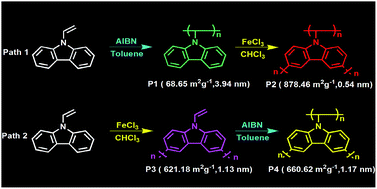Effect of two facile synthetic strategies with alterable polymerization sequence on the performance of N-vinyl carbazole-based conjugated porous materials†
Abstract
Four (N-vinyl carbazole)-based polymers were prepared through two facile synthetic strategies including both free radical polymerization and oxidative polymerization in different sequences. N-vinyl carbazole containing an ethylenic bond and a carbazole group is a superior candidate to study the effects of polymerization methods and sequences on the performance of conjugated microporous materials (CMPs). P2 was obtained with a BET of 878.46 m2 g−1, 12.8 times that of P1 (68.65 m2 g−1) in path 1, whereas in path 2, P3 (621.18 m2 g−1) and P4 (660.62 m2 g−1) were obtained without obvious difference in surface areas and pore structure. The dominant pore of linear polymer P1 centered at 3.94 nm, which is consistent with the polymers of intrinsic microporous (PIMs) analogues, and the counterparts P2 (ultramicropores, 0.54 nm), P3 (1.13 nm), and P4 (1.17 nm) are typical CMPs. P2 shows the best gas uptake abilities and absorbancies for organic solvents among the polymers. The results demonstrate that polymerization methods and sequences can have a great influence on the performance of materials, and only by careful choice of polymerization method and fine adjustment of the polymerization sequence can one obtain conjugated porous materials with optimum performance. Path 1, which is cost effective, high yielding and pollution free, should be regarded as the optimum selection process to prepare the N-vinyl carbazole-based porous materials. The reusability of P2 and P4 shows their impressive stability after 5 cycles of use or acid/base treatment. It is worth noting that P2 and P4 with a high porosity and pore volume are promising materials in carbon dioxide uptake, and in methane and hydrogen storage.


 Please wait while we load your content...
Please wait while we load your content...